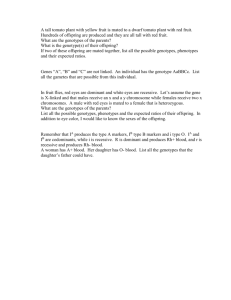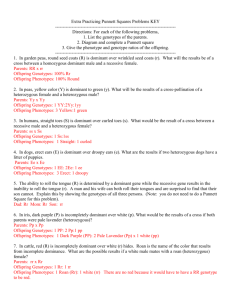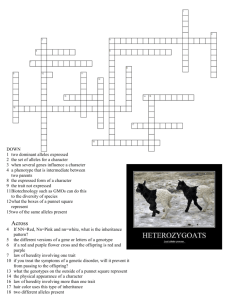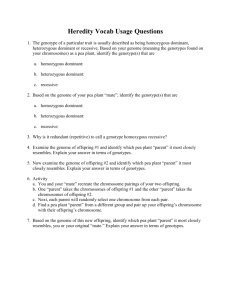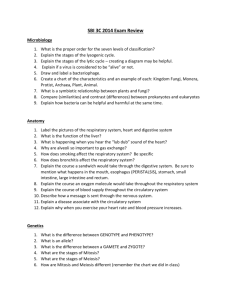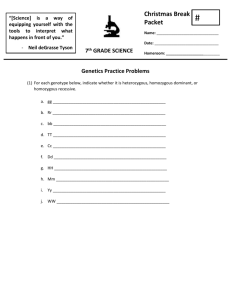AP Genetic Problems
advertisement
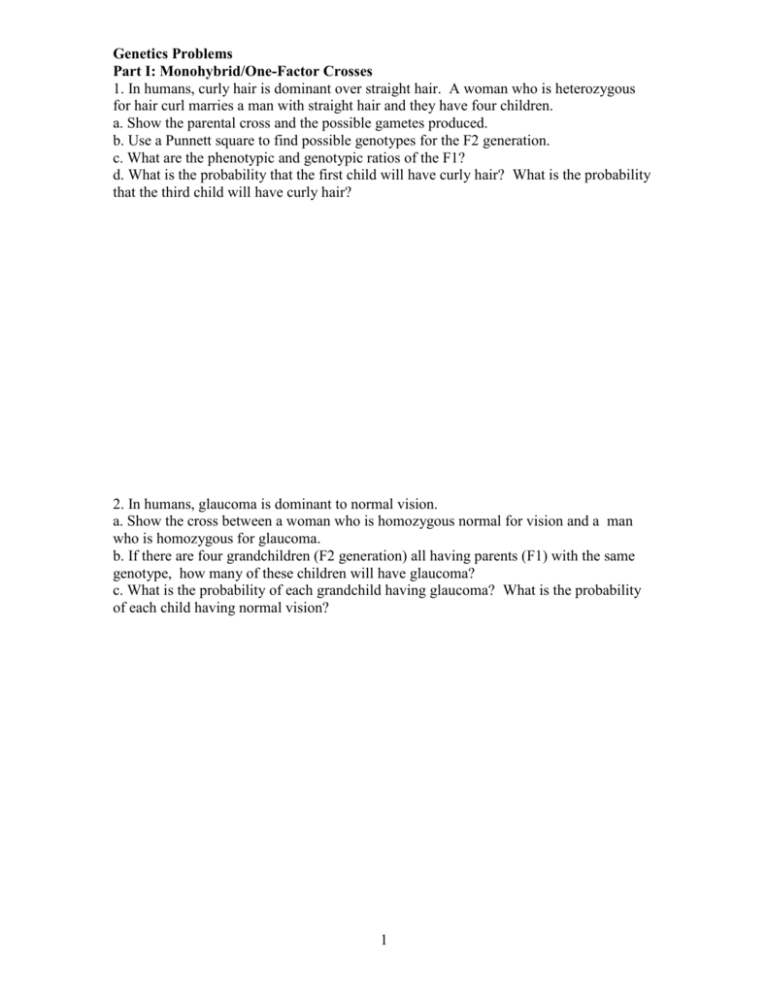
Genetics Problems Part I: Monohybrid/One-Factor Crosses 1. In humans, curly hair is dominant over straight hair. A woman who is heterozygous for hair curl marries a man with straight hair and they have four children. a. Show the parental cross and the possible gametes produced. b. Use a Punnett square to find possible genotypes for the F2 generation. c. What are the phenotypic and genotypic ratios of the F1? d. What is the probability that the first child will have curly hair? What is the probability that the third child will have curly hair? 2. In humans, glaucoma is dominant to normal vision. a. Show the cross between a woman who is homozygous normal for vision and a man who is homozygous for glaucoma. b. If there are four grandchildren (F2 generation) all having parents (F1) with the same genotype, how many of these children will have glaucoma? c. What is the probability of each grandchild having glaucoma? What is the probability of each child having normal vision? 1 3. Give the phenotypic and genotypic ratios of the possible offspring produced when a heterozygous brown-eyed man marries a heterozygous brown-eyed woman. Brown eyes are dominant over blue eyes (recessive). 4. Two brown-eyed parents have two children with blue eyes. Give the genotypes of each member of the family. 5. Albinism (lack of pigment) in humans is caused by a recessive gene. If normal parents have an albino child, what is the probability that their next child will be normal for pigment? 6. Free ear lobes are dominant to attached ear lobes in humans. a. If a homozygous, recessive male marries a homozygous dominant female, what will be the phenotypic and genotypic ratios of their offspring? b. If one of these female children were to marry a man with her genotype, what would be the phenotypic ratio of their children? 7. A homozygous, dominant individual for long eyelashes is crossed with a heterozygous individual. What is the probability that they will produce offspring with short eyelashes? Long lash is dominant to short. 2 8. The ability to taste the drug phenyl-thio carbamide (P.T.C.) is due to a dominant gene. A non-taster man marries a taster woman whose father was a non-taster. a. What will be the expected genotypes of their four children? b. What would be the expected phenotypes for ten children? c. What is the probability that their first child has the heterozygous genotype? d. What could have been the genotype of this woman’s father? 9. The gene for yellow coat colour in mice is lethal in a homozygous condition. Yellow coat is dominant to gray coat. What will be the ratio of viable phenotypes in a cross between 2 yellow-coated mice? 10. Polled (hornless) condition in cattle is dominant over horned condition. A polled bull is bred to three cows with the following result: Cow A (horned) = polled calf Cow B (horned) = horned calf Cow C (polled) = horned calf a. What are the genotypes of the four parent animals? b. What further offspring would you expect these matings might have produced? 3 Dihybrid/Two-Factor Crosses 12. In watermelons the genes for green color and for short shape are dominant over their alleles for striped color and for long shape. a. Suppose a plant with long striped fruit is crossed with a plant heterozygous for both these characters. What are the parent genotypes? b. What possible gametes will be produced by each parent? c. What phenotypes and genotypes would this cross produce in the F1 and in what ratios? 13. In pepper plants, green (G) fruit color is dominant to red (g) and round (R) fruit shape is dominant to square (r) fruit shape. These two genes are located on different chromosomes. a. What gametes will be produced by a heterozygous green, round plant? b. If two such heterozygous plants are crossed, what genotypes and phenotypes will be seen in the offspring and in what proportions? 4 Answers to Part I 1a. Parents: Cc x cc Gametes: C & c (Parent 1) and c (Parent 2) b. Punnett Square: Since parent 2 can only donate c, the offspring will have a 50% of being Cc and a 50% chance of being cc c. 1:1 for pod colour and genotype d. The probability is 1/2 or 50% for both since they are independent events. 2a. Alleles: G = glaucoma, g = normal Parents: gg X GG b. F1 individuals are all Gg. The F2 individuals are found by crossing Gg x Gg. F2 is 1GG: 2Gg: 1gg (3 Glaucoma: 1 normal vision) c. Glaucoma F2 (grandchild)=3/4 or 75%, Normal F2 (grandchild)=1/4 or 25% 3. 3:1 for brown eyes to blue eyes, and 1:2:1 for BB:Bb:bb 4. Parents: Bb, Children: bb 5. Both parents must be heterozygous in order to have an albino child. Therefore, P = 3/4 or 75% that their next child will be normal for pigment. Each child is an independent event, so this probability holds for all children. 6a. All of their offspring will be heterozygous for free ear lobes (Ff). b. Ratio is 3:1 for free ear lobes to attached ear lobes. 7. P = 0 since the recessive allele is always paired with the dominant allele. 8a. Two children would be Tt, while the other two would be tt. b. Due to the 1:1 genotype ratio, 5 children would be able to taste P.T.C., while the other 5 would be non-tasters. c. P = 1/2 or 50% d. tt 9. Ratio is 2:1 for yellow coat to gray coat. 10a. cow A: pp, cow B: pp, bull: Pp, cow C: Pp b. All of the cows could produce either polled or horned calves. 5 Part II: Mixed Problems A. Incomplete Dominance 1. A rooster with gray feathers is mated with a hen of the same phenotype. Among their offspring, 15 chicks are gray, 6 are black, and 8 are white. What is the simplest explanation for the inheritance of these colors in chickens? What offspring would you predict from the mating of a gray rooster and a black hen? 2. In some plants, a true-breeding, red-flowered strain gives all pink flowers when crossed with a white-flowered strain: RR (red) x rr (white) --- Rr (pink). If this is the F1 cross result, what will be the genotypic and phenotypic ratios in the F2 generation? B. Codominance 3. In cows, red and white fur colors are codominant. A red cow is RR, a white cow is WW and a roan cow is RW. If a red cow is crossed with a roan cow, what are the genotypic and phenotypic ratios of the offspring? Is it possible to have a white offspring? 4. A cross between a black cat & a tan cat produces a tabby pattern (black & tan fur expressed equally together). a) Why does this illustrate codominance rather than incomplete dominance? b) What ratio of kittens would have tan fur if two tabby cats are crossed? 6 C. Sex Linked Traits 7. Hemophilia is a sex-linked trait where XH gives normal blood clotting and is dominant to the hemophilia allele Xh. Give the genotypes of a. A woman with normal blood clotting whose father had hemophilia b. A normal man whose father had hemophilia. c. What is the probability that a mating between these two individuals will produce a child, regardless of sex, that has hemophilia? d. If this couple has a daughter, what is the probability that the daughter will be a carrier of the hemophilia trait? e. What is the probability a daughter would have hemophilia? f. If this couple has a son, what is the probability he will have hemophilia? 8. The inheritance of color blindness in humans is due to a recessive gene located on the X chromosome (X linked). XN is normal color sight and is dominant to Xn (color blind) a. If a color-blind boy is born to parents both of whom have normal vision, what are the genotypes of the three individuals? b. What is the probability that the couple will have a color-blind daughter? 7 D. Multiple Alleles 9. In the ABO blood system, A and B are codominant. O is recessive. Therefore, a person with blood type “A” can either be AA or AO. A person with blood type “B” can either be BB or BO. A person who is blood type “O” is OO. A person can also be type AB. For the ABO blood system, what are the predicted genotypes and the phenotypes and their frequencies for the offspring of the following matings? a) AA x AB b) AO x OO c) BB x OO d) AO x BO 10. What offspring are not allowed for each mating in problem 9? 11. Color patterns in a species of duck are determined by one gene with three alleles. Alleles H and I are codominant, and allele i is recessive to both. How many phenotypes are possible in a flock of ducks that contains all the possible combinations of these three alleles? 8 14. The Rhesus blood group gene is actually complicated, but is usually simplified in textbooks as having two alleles, a `plus` (+) allele and a `minus` (-) allele. The + allele is dominant to the - allele. Typical blood typing combines the phenotype at the ABO gene (see multiple alleles above) with the phenotype at the Rhesus locus (e.g., B+, O-, etc.). a. A man has the genotype AA/+- and a woman has genotype BO/++. What is their blood “type”? b. Calculate the genotypes, phenotypes, and expected frequencies for the offspring from a mating between this man and woman. c. Calculate the genotypes, phenotypes, and expected frequencies for the offspring from a mating between a man with the genotype AO/+- and a woman with the genotype BO/++. 9 Solutions to Mixed Problems 1. P = Gray x Gray; F1 = 15 Gray, 6 black, 8 white. Say that BB = black, bb = white, and Bb = gray. Then a Bb x Bb should result in a ratio of 1:2:1 for white (bb), gray (Bb), and black (BB), respectively. The actual ratio observed is 1.1:2.0:0.8. Therefore conclude that the simplest explanation is incomplete dominance where gray is the heterozygote. The phenotypes of the offspring which would arise from a mating between a gray rooster (Bb) and a black hen (BB) would have to be half black (BB) and half gray (Bb) since we know that the black hen has to be a homozygote (otherwise she would be grey). 2. If two pinks are crossed (Rr) x (Rr), the offspring genotypic ratio will be 1 (RR):2 (Rr):1 (rr), which is 1 Red:2 Pink:1 White. 3. This cross is RR x RW. The red cow can only contribute a R and the roan cow can contribute either a W or R. The offspring genotypes will be 1 RR: 1 RW, and the phenotypes will be 1 red: 1 roan. There will be no white offspring. 4a. Because the two fur colors are expressed equally. In cases of incomplete dominance, one color partially masks the other (red partially masks white, giving pink). 4b. The cross is BT x BT. Each cat can contribute a B or T. The offspring genotypes will be 1 BB: 2 BT: 1 TT, and the phenotypes will be 1 black: 1 tabby: 1 tan. 5.1 aabbccdd = ¼ x ¼ x ¼ x ¼ = 1/256 5.2 AaBbCcDd = ½ x ½ x ½ x ½ = 1/16 5.3 AABBCCDD = ¼ x ¼ x ¼ x ¼ = 1/256 5.4 AaBBccDd = ½ x ¼ x ¼ x ½ = 1/64 5.5 AaBBCCdd = ½ x ¼ x ¼ x ¼ = 1/128 6.1 AaBbCc = 1, 100%, all 6.2 AAbbCC = ½ x ¼ x ¼ = 1/32 6.3 AaBbCc = ½ x ½ x ½ = 1/8 6.4 AaBbCc = 1 x ½ x 1 = 1/2 7a. The woman has normal clotting so she has one XH (from her mother) but she got Xh from her father. 7b. The man is XHY since he got the Y from his father and he is normal so must be XH 7c. The Punnett Square for this cross: XH Xh H H H X X X Xh XH Y XH Y Xh Y Each child has a 1/2 chance of being male and males have a 1/2 chance of being affected; so 1/4 chance of a child with hemophilia. 7d.1/2 chance of being a carrier 7e. 0 chance that a daughter would have hemophilia 7f. 1/2 chance 8a. Father is XNY Boy is XnY (receives Y from father, must receive Xn from mother) Mother is XNXn 10 8b. The father can only contribute XN to his daughters, so there is no chance that any daughter will be colorblind 9a. ½ AA, ½ AB ½ blood type A, ½ blood type AB 9b. ½ AO, ½ OO ½ blood type A, ½ blood type O 9c. All BO All blood type B 9d. ¼ AB, ¼ AO, ¼ OB, ¼ OO ¼ blood type AB, ¼ blood type A, ¼ blood type B, ¼ blood type O 10a. blood type B, blood type O 10b. blood type B, blood type AB 10c. blood type A, blood type AB, blood type O 10d. all blood types allowed 11. Possible genotypes are HH, HI, Hi, II, Ii, and ii. Note that Hi has the same phenotype as HH, and Ii has the same phenotype as II. Therefore there are six minus two possible phenotypes (four phenotypes possible). The genetics here are identical to that of the ABO blood group. 12a. The striped, long fruit is homozygous recessive for both traits. Call the alleles G (green), g (striped), s (long) and (short). Thus, the long striped parent has the genotype gg ss and the heterozygous parent has the genotype Gg Ss. 12b. The ggss parent can only produce gs. The GgSs parent can produce GS, Gs, gS, and gs. 12c. In the F1 generation there would be a total of four genotypes, each present equally. Since one of the parents can only produce gs, that gamete can combine with the four possible gametes produced by the other parent in equal proportions. The possible offspring would be Gg Ss (green and short), gg Ss (striped and short), Gg ss (green and long), and gg ss (striped and long). 13a. This green round plant is GgRr and will produce GR, Gr, gR, and gr gametes in equal proportion since the genes are unlinked. 13b. This will give 9/16 green round, 3/16 green square, 3/16 red round, and 1/16 red square phenotypes; the genotypes are given in the Punnett square below. GR Gr gR gr GR GGRR GGRr GgRR GgRr G_R_ = green, round G_rr = green, square Gr GGRr GGrr GgRr Ggrr gR GgRR GrRr ggRR ggRr ggR_ = red, round ggrr = red, square 14a. Man = “A+” (A positive), Woman = “B+” (B positive) 11 gr GgRr Ggrr ggRr ggrr 14b. Man contributes A+ or A– Woman contributes B+ or O+ Punnett square/possible offspring genotypes A+ AB+ A+B+ A+BO+ A+O+ A-O+ Possible offspring phenotypes: AB+ (AB positive), A+ (A positive), in equal numbers, ratio of 1:1 14c. Man contributes A+, O+, A- or OWoman contributes B+ or O+ Possible offspring genotypes: A+B+, A+O+, O+B+, O+O+, A-B+, A-O+, O-B+, and O+OPossible offspring phenotypes: AB+ (AB positive), A+ (A positive), B+ (B positive) and O+ (O positive) – in equal numbers, ratio of 1:1:1:1 12 Final Review Genetics Problems 1. For the purpose of this problem assume that in humans the gene for brown eyes is dominant to that for blue eyes. a. A brown-eyed man marries a blue-eyed woman, and they have eight brown-eyed children. What are the genotypes of all the individuals in the family? b. What is the probability that the first child produced in parents who are both heterozygous for brown eyes will be blue-eyed? c. If the first child is a brown-eyed girl (same parents as in b), what is the probability that the second child will be blue-eyed? d. What is the probability that the second child will be a blue-eyed boy (same parents as in b)? 2. A woman with type A blood has parents who are both type AB and a husband who is a type B. They have a child with type A blood. a. What are the genotypes of the woman, her husband and their child? b. What is the probability that their second child will have type AB blood? 3. In guinea pigs, curly fur is dominant to straight fur, and speckled fur is dominant to solid fur. a. If you had a guinea pig with curly, speckled fur, how could you determine whether she was homozygous or heterozygous for these traits? b. Assume she is heterozygous for both traits. Show the test cross and the results. c. What would the results be if she were homozygous dominant for both traits? 13 4. Of 1217 offspring produced in a cross of one variety of plants, 223 had violet flowers and long stems, 67 had pink flowers and long stems, 697 had violet flowers and short stems, and 230 had pink flowers and short stems. a. What are the two traits in this cross? b. What are the two alleles for each trait? c. Identify the dominant and recessive alleles for each trait. d. Show the cross between two heterozygous violet, short plants. Does the ratio match that of the original numbers given in the problem? Explain. 5. A woman with hemophilia marries a normal man. a. Give the genotypes of these individuals b. Show the cross and expected results (make sure to use proper notation) c. What is the probability that a son will have hemophilia? d. What is the probability that a daughter will have hemophilia? e. Suppose the daughter marries a normal man. Show their genotypes and the cross. f. What is the probability that their son will have hemophilia? What is the probability that their daughter will have hemophilia? 14 6. Given the following information about the inheritance of characteristics in pea plants, answer the questions below: Traits Y (yellow) is dominant to y (green) R (round) is dominant to r (wrinkled) B (bitter) is dominant to b (sweet) S (smooth) is dominant to s (hairy) L (long pod) shows incomplete dominance to 1 (short pod) (Ll is medium in length) Given this parental cross: Yy Rr Bb SS Ll (male) x yy RR Bb Ss Ll (female) a. What is the phenotype of each parent? b. How many different gametes can be formed by the female plant? What are they? c. How many different gametes can be formed by the male? d. How many different phenotypes are possible in the F1 offspring? What are they? e. What percent of the F1 individuals will be green, bitter, and smooth? hairy, medium, and sweet? round, bitter, and long? 15 Solutions to Final Genetics Problems 1a. BB = man, bb = woman, Bb = children b. ¼ c. ¼ d. ½ x ¼ = 1/8 2a. AA = woman, BO = man, AO = child b. ½ 3a. Conduct a test cross: mate unknown with homozygous recessive individual 3b. C=curly, c=straight S=speckled, s=solid CcSs x ccss cs CS CcSs Cs Ccss cS ccSs cs ccss ¼ = Curly & Speckled ¼ = Curly & solid ¼ = straight & Speckled ¼ = straight & solid 3c. CCSS x ccss would result in all CcSs (Curly & Speckled) 4a. Flower color and stem length 4b. Flower color: violet & pink Stem length: long & short 4c. Flower color: 223 + 697 = 920 violet (dominant) and 67 + 230 = 297 pink (recessive) Stem length: 697 + 230 = 927 short (dominant) and 67 + 223 = 290 long (recessive) 4d. V=violet, v = pink S=short, s = long Cross: VvSs x VvSs VS Vs vS vs VS VVSS VVSs VvSS VvSs Vs VVSs VVss VvSs Vvss vS VvSS VvSS vvSS vvSs vs VvSs VvSs vvSs vvss 9/16 Violet & Short (~ 697/1217) 3/16 Violet & long (~ 223/1217) 3/16 pink & Short (~ 230/1217) 1/16 pink & long (~ 67/1217) The Punnett Square results are very close to the results from the actual cross. 5a. Xh Xh = woman, XHY = man 5b. Xh Xh XH XH Xh XH Xh Y Xh Y Xh Y 16 5c. All sons will have hemophilia 5d. No daughters will have hemophilia 5e. Normal man = XHY Daughter = XH Xh XH Xh XH XH XH XH Xh Y XH Y Xh Y 5f. Son has 50% chance of having hemophilia, daughter has no chance 6a. Male = yellow, round, bitter, smooth and medium Female = green, round, bitter, smooth and medium 6b. Female can produce 8 different gametes: yRBSL, yRbSL, yRBsL, yRbsL, yRBSl, yRbSl, yRbsl and yRBsl (Note: To determine the number, use the statement 2n, where “n” is the number of heterozygous traits. In this case, three of the traits are heterozygous, so the answer is 23 = 8). 6c. Male can produce 16 different gametes. 6d. All offspring are round and smooth. In addition, there are the following phenotypes: green, bitter, long green, bitter, medium green, bitter, short green, sweet, long green, sweet, medium green, sweet, short yellow, bitter, long yellow, bitter, medium yellow, bitter, short yellow, sweet, long yellow, sweet, medium yellow, sweet, long 6e. Green, bitter & smooth: ½ x ½ x 1 = ¼ (25%) Hairy, medium & sweet: None (all are smooth) Round, bitter & long: 1 x ¾ x ¼ = 3/16 (18.75%) 17

